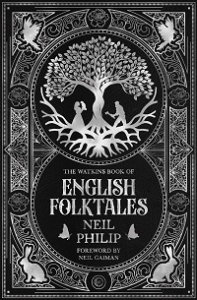Sorrow and Love: The Poetry of the English Folktale
Neil Philip’s superb collection of English folktales, The Watkins Book of English Folktales contains over one hundred stories captured in the form they were first collected in past centuries. As he reveals in this article, these stories have a poetry all of their own.
 On 26 September 1914, an English Romany named Gus Gray told a story called ‘Sorrow and Love’. It’s an English version of an international folktale type, known as ‘The Search for the Lost Husband’, or sometimes after its first known incarnation in the Metamorphoses of Apuleius, as ‘Cupid and Psyche’. It was a Scottish story of this type, ‘The Black Bull of Norroway’ that gave Tolkien his idea of the eucatastrophe, the happy ending achieved after much sorrow and hardship.
On 26 September 1914, an English Romany named Gus Gray told a story called ‘Sorrow and Love’. It’s an English version of an international folktale type, known as ‘The Search for the Lost Husband’, or sometimes after its first known incarnation in the Metamorphoses of Apuleius, as ‘Cupid and Psyche’. It was a Scottish story of this type, ‘The Black Bull of Norroway’ that gave Tolkien his idea of the eucatastrophe, the happy ending achieved after much sorrow and hardship.
Gus Gray told the collector T. W. Thompson nine stories in this one storytelling session. Thompson regarded his narrative skills very highly, describing him as ‘even in ordinary conversation… a man of beautiful speech’, who was capable in his storytelling of rising to heights of poetry. Thompson writes, ‘I remember particularly (who could forget it?) his description of Squire King Kaley’s mare in ‘Sorrow and Love’ as the rider reined her in to keep pace with the old farmer’s cob. “The bit was hard back in her mouth, and the foam flying like big flakes o’ snow; the veins on her neck was standing out like rope; the sweat dripping off her like a hail o’ bullets; her chestnut coat black wi’ sweat, and shiny like jet. She was all of a dither; at a touch she’d ha’ jumped out’n her skin.”’
This is an example of one of the kinds of poetry that is evident in the English folktale, the poetry of verbal dexterity and daring, the creation of a vivid picture or a dramatic scene on the wings of the moment. Another kind of poetry can be found in the way the stories unfold in what Joseph Jacobs called ‘bright trains of images’. A Derbyshire version of ‘Beauty and the Beast’, ‘The Small-Tooth Dog’ demonstrates this well. When the dog rescues a merchant who has been beset by thieves, the merchant offers him anything he wants in return. A fish that can speak twelve languages; a goose that lays golden eggs; a mirror in which you can see what anybody is thinking about. But the small-tooth dog refuses them all; what he wants is the merchant’s daughter.
These bright trains of images can be expressed in vivid language that is highly personal to the individual storyteller, which will vary according to the context and audience for each particular narration. But they can also be told in a language of inherited phrases and formulae. This is particularly obvious in the formal openings and closures of many tales. Here, for instance, is the opening of a version of ‘Jack the Giant Killer’, collected in Herefordshire in 1909 from W. Colcombe.
‘Once upon a time—a very good time it was—when pigs were swine and dogs ate lime, and monkeys chewed tobacco, when houses were thatched with pancakes, streets paved with plum puddings, and roasted pigs ran up and down the streets with knives and forks on their backs crying “Come and eat me!” That was a good time for travellers.’
‘Then it was I went over hills, dales, and lofty mountains, far farther than I can tell you tonight, tomorrow night, or any other night in this new year. The cocks never crew, the winds never blew, and the devil has never sounded his bugle horn to this day yet.
‘Then I came to a giant castle; a lady came out of the door with a nose as long as my arm. She said to me, she says, “What do you want here? If you don’t be off from my door I’ll take you up for a pinch of snuff.” But Jack said “Will you?” and he drew his sword and cut off her head.’
One of the things that interests me about this opening is the way it works its way by means of formulae into the fairy tale proper, the moment when ‘I’ becomes ‘Jack’.
So there is verbal creativity involved in folktale narration, but also verbal memory, and these two elements are differently balanced in every single telling.
Some may be surprised to learn of the existence of a whole range of English folk narrative, including jokes, anecdotes, local legends, stories of ghosts, fairies, mermaids and witches, as well as fairy tales with all their magic and wonder. In his Foreword to The Watkins Book of English Folktales, Neil Gaiman recalls how when he was a child, he thought that ‘folk stories and fairy tales came from somewhere else, not England’. When he read the book in its first incarnation thirty year ago, ‘it changed the inside of my head’. Reverberations from this can be felt in Gaiman’s Sandman, in his novella Snow, Glass, Apples (inspired by Traienti Lovell’s version of ‘Snow-White’), and in Coraline, in which Coraline’s scary ‘other mother’ with her big black button eyes has her roots in ‘The Pear-Drum’, with its ghastly new mother ‘with glass eyes and a wooden tail’.
‘The Pear-Drum’ is an interesting example of how stories dip in and out of the oral and written traditions, from mouth to page and back again. It started out as a literary fairy tale, ‘The New Mother’, published by Lucy Clifford in 1899. It haunted the imagination of the historian of children’s literature, F. J. Harvey Darton, who wrote that, ‘Getting on for fifty years after I met her first, I still cannot rid my mind of that fearful creation’. J. Y. Bell contributed an orally transmitted version of the story, now called ‘The Pear-Drum’, to the journal Folklore in 1955. Since then it has turned into Alan Garner’s ‘Iram, Biram’ as well as morphing into an elemental strand of Coraline.
The poet John Clare provides another example of this cross-fertilization. Clare knew folktales both from oral narration (his father had a store of them) and from chapbook retellings. When he writes about Cinderella in The Shepherd’s Calendar, he mixes details derived from Perrault’s ‘Cendrillon’, such as the pumpkin carriage and rat coachmen, with elements from a different, local, version, in which it is a ‘golden glove’ that Cinderella loses at the ball, not a glass slipper.
The imaginations of writers such as Clare, Thomas Hardy, and Charles Dickens were suffused with English folktales – The Watkins Book of English Folktales contains two stories from Hardy, and two from Dickens, ‘Captain Murderer’ and ‘Chips’. Both of these gruesome stories were told to him by his childhood nurse, Mary Weller, who seems to have specialised in ‘frighteners’. Dickens recalled how she told him ‘Captain Murderer’ hundreds of times, with ‘a fiendish enjoyment of my terrors, and used to begin, I remember—as a sort of introductory overture—by clawing the air with both hands, and uttering a long low hollow groan’. This reminds us, of course, that oral storytelling is not solely about words, but that it incorporates gestural and performative elements too.
Shakespeare knew and referred to English folktales, often in an obliquely allusive way that suggests he expected his audience to be familiar with them too. So a throwaway line in Hamlet, ‘They say the owl was a baker’s daughter’, turns up as a folktale in both Gloucestershire, in which the mean baker’s daughter is transformed into an owl by ‘Our Saviour’ himself, and in Herefordshire, when the punishment is inflicted by a fairy.
In Gus Gray’s ‘Sorrow and Love’, the strong and resourceful heroine goes through terrible trials, but at the end, ‘Squire took bride in his arms and kissed her. “You’ve had your sorrow; now you are going to have love.”’
And there is Tolkien’s eucatastrophe, ‘the sudden joyous “turn”’ at the end of a fairy tale, yielding ‘a fleeting glimpse of Joy, Joy beyond the walls of the world, poignant as grief’. Both sorrow and love.
Be bow bend it,
My tale’s ended.
If you don’t like it,
You may mend it.
 Neil Philip is a writer, folklorist and poet and a longtime contributor to Books for Keeps.
Neil Philip is a writer, folklorist and poet and a longtime contributor to Books for Keeps.
The Watkins Book of English Folktales is published by Watkins Publishing, 978-1786787095, £14.99 hbk.



